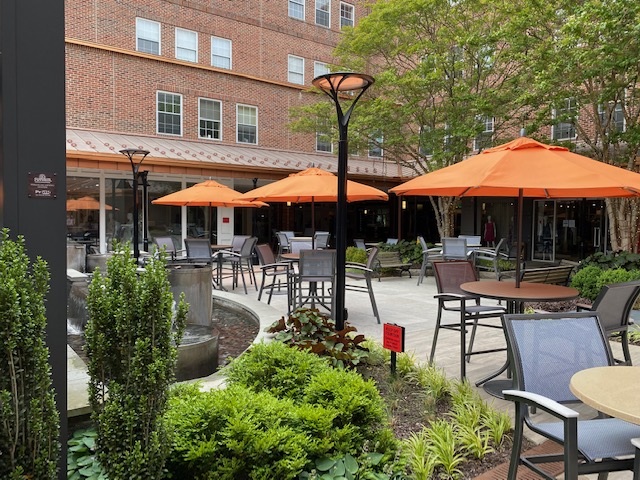
Although City Café was a casualty of the COVID crisis, Gino Cardinale, who co-owned the cafe along with his husband, Bruce Bodie, says that Tark’s Grill, which they also own, will suffer no such fate. Thanks to a spacious deck, a stunning new interior, and a new menu of carryout options featuring family meals, the restaurant in Lutherville-Timonium’s Green Spring Station is well on the road to recovery.
“Having curbside takeaway has kept us financially solvent at Tark’s,” says Cardinale of his Lutherville-Timonium restaurant set inside Greenspring Station, “but more importantly, we have stayed connected with our guests and made a lot of new connections, as well.”
We spoke with Cardinale about his days at City Café, how Tark’s is surviving, and why restaurant work has become his life’s calling.
How are you doing with in-person dining?
We opened at 50 percent as soon as Baltimore County gave the green light, which coincided with the state, but the biggest thing for us at Tark’s is that we had just completed an extensive top-to-bottom interior renovation at the end of 2019. We did that in late August through the end of October. We put seating outside late last summer and fall for about 100 people and it worked out great. While we were renovating, our sales stayed really strong, which was fantastic and much needed. The goal for the renovation was to make the inside as charming as the courtyard, and we knew that the test of that was the winter to see how business was. We had a really busy holiday season but most impressively in January and February and the first couple of weeks in March, we were booming—we had the best first quarter in the restaurant’s history. And then COVID hit.
So where did you go from there? Your carryout menu is getting rave reviews.
We built out a takeaway menu based on our concept and kitchen’s strengths and put together great family meal options knowing that a lot of folks in the area would have their kids back from college. We weren’t sure how that was going to do, but we brought in a very small crew of people willing to work during that time and it really took off. We were doing well over 100 orders a night. Most people were placing large orders to feed households. That helped the business. At one point, it was strong enough that it kept us afloat and we weren’t racking up a bunch of bills that were going for 90 days. We got a lot of rave reviews on the takeaway. When Gov. Hogan announced that outdoor dining was going to be permitted, he was still talking when our phone started ringing for reservations.
The public has been very amenable to working through these changes with restaurants, and that’s why being in a restaurant that might not conceive of itself as a carryout place or outdoor dining place needs to take a shot, because people do want to come out. Dining out is a major part of our lifestyle. People don’t want to surrender that completely, so they will work with you. This situation has taught us that you can work collaboratively with your guests. When our phone was ringing for reservations, it was also ringing with people calling to say, “Please don’t stop the takeaway—we are dependent upon it and not ready to come back yet.”
“When Gov. Hogan announced that outdoor dining was going to be permitted, he was still talking when our phone started ringing for reservations.” —Gino Cardinale, co-owner Tark’s Grill
How is indoor dining going?
Indoor dining is slow to come back. Maybe it’s the time of year we are in, but when indoor dining opened up, people were not breaking down the door down to sit inside. They still want to be outside or do carryout. We lowered our prices to fit a takeout model and people appreciated that. Full-service restaurants that dabbled in carryout early on in the crisis with their regular price point may not have gotten the business they wanted. It’s hard to put something in a carryout box and charge $38.
I was so sad to hear about the closing of City Café. Can you tell me what happened?
When COVID-19 started, we were very worried very quickly about what it would mean. We operated City Café for 25 and a half years, so we knew the business model inside and out. In the industry, we call it a flat-seat restaurant. City Café was a large restaurant that seated 125 people at one time. Typically, it filled up every day at noon with that number of people and cleared out at 1:30. On Saturday and Sunday for brunch, we’d routinely do 300 to 400 people, and people would wait 30 to 40 minutes for a table at nighttime. It was known as a pre-theater Meyerhoff restaurant and packed out by 6:30 p.m—that was the City Café business model and it was large enough to handle those crowds and skilled enough to do it well. We really got nervous as we started hearing about the phase re-openings and diminished capacity, and thought about what that was going to mean for City Café.
City Café couldn’t break even at 50 percent capacity. That was a deal breaker. Mt. Vernon is also very quiet in the summer when school is out and the cultural season is over, but it’s also very busy in the spring and we got wiped out in May for rehearsal dinners and graduations. The group dining got wiped out, the cultural season got wiped out, the spring got wiped out, and large capacity got wiped out. That’s what did it. The red ink was the worry—an entire year couldn’t be wiped out and have us survive.
“The public has been very amenable to working through these changes with restaurants, and that’s why being in a restaurant that might not conceive of itself as a carryout place or outdoor dining place needs to take a shot, because people do want to come out. Dining out is a major part of our lifestyle.”
Can you share a favorite memory of your time at City Café?
City Café was Baltimore’s most well-known restaurant for diversity, before diversity was the buzz word that it is today. The fact that Bruce and I opened it at 26 in 1994 as two out-of-the-closet gay men, it was always a welcoming space for people of every walk of life. City Café was a very special place for a diverse group of people, but my favorite memory was watching civil rights barriers come down over the years and celebrating them, so when the [same-sex marriage referendum], for example, was approved by voters of Maryland, we had a huge party in 2012. And then when the Supreme Court ruling came later, we had a huge party and threw open the doors and invited the whole community. They were watershed moments in our country. On a personal level, Bruce and I have been together for 29 years, but we always said we’d get legally married when Maryland legalized it. We got married at 2013 and had our wedding celebration at City Café on the actual night of our 22nd anniversary as a couple. Governor O’ Malley deserves a lot of credit for for breaking the gay marriage barrier in Maryland. We got to know Governor O’Malley when he was mayor, and his wife, Katie O’Malley, married us.
Would you do it again?
I would absolutely do it again. This crisis has been so devastating to the restaurant business that it’s going to scare people off who may have been aspiring to one day own their own restaurant or become a chef. They’ve seen how cataclysmic this is. But owning a restaurant is uniquely rewarding because, while you’re getting to work for yourself and experiencing life as a business person, you’re connecting with people and making a difference in their lives—even when you don’t know you’re doing it.
“City Café was Baltimore’s most well-known restaurant for diversity, before diversity was the buzz word that it is today. The fact that Bruce and I opened it at 26 in 1994 as two out-of-the-closet gay men, it was always a welcoming space for people of every walk of life.”
Can you elaborate?
We had a tragedy at City Café in 2001. My older brother and business partner, John, was murdered outside of the restaurant. It was a robbery set up by an employee who worked there. He was walking up to Mercantile bank at Charles and Chase. At that time, we were six years into the business and I was pretty adamant that we were not reopening after that occurred. And then, as things played out—my brother was an ordinary guy—1,000 people came to his funeral. And there was a vigil outside of City Café and 1,000 people attended. I never realized the difference this little coffee shop, which is what it was at that time, was making in people’s lives in the community and the difference he made. He was a front-of-the-house guy and everyone loved him. It changed my perspective on the restaurant business. I knew from that point on that, yes, we have to cook the food, mop the floor, and pay the bills—it was all that stuff and it’s hard work—but I can’t think of too many things that an average person can get into that can make such a difference in a community’s life. That sealed the deal for me.
Why do restaurants matter?
They matter because people are social creatures and we are not meant to just be isolated in our own little world all the time. People want to come out and interact with others and they want to break bread together. That’s become very much ingrained in our culture. It was a golden time to come in 26 years ago. There’s been a rapid expansion and constant evolution in creating spaces and a culture. We see the value in it, especially around Baltimore where you see thriving small restaurants. Young people are able to come in and create these awesome cultural experiences with foods from other places.
“Owning a restaurant is uniquely rewarding because you’re connecting with people and making a difference in their lives—even when you don’t know you’re doing it.”
Was this your original dream—to go into hospitality?
Somewhere in my upbringing it was pushed on me to work for myself. I always knew one way or another I’d be an entrepreneur. We were inspired to open a coffee shop in an amazing piece of architecture, in a cool, gay-friendly neighborhood in 1994. At that time, I didn’t think it would become a lifelong career, but that goes back to why restaurants matter. People wanted to get out of their house and come to a cool place and be around other people. My brother was little bit older than me, and he had an incredible sense of that before I did. He taught me why it matters—and why it matters is important. If you don’t think it matters, you’re not going to endure. It is a hard business.
